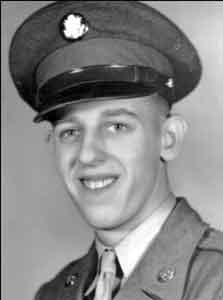Raymond Feenstra from Beaver County Pennsylvania.
Service era: Korea
Date of death: Saturday, March 10, 1951
Death details: By mid-November 1950, U.S. and Allied forces had advanced to within approximately sixty miles of the Yalu River, the border between North Korea and China. On November 25, approximately 300,000 Chinese Communist Forces (CCF) “volunteers” suddenly and fiercely counterattacked after crossing the Yalu. The 2nd Infantry Division, located the farthest north of units at the Chongchon River, could not halt the CCF advance and was ordered to withdraw to defensive positions at Sunchon in the South Pyongan province of North Korea. As the division pulled back from Kunu-ri toward Sunchon, it conducted an intense rearguard action while fighting to break through well-defended roadblocks set up by CCF infiltrators. The withdrawal was not complete until December 1, and the 2nd Infantry Division suffered extremely heavy casualties in the process. Sergeant First Class Raymond Feenstra Jr., who joined the U.S. Army from Pennsylvania, was a member of the Medical Company, 9th Infantry Regiment, 2nd Infantry Division. He was captured by the CCF during the fighting withdrawal from Kunu-ri on December 1, 1950. SFC Feenstra was marched to a holding village near the Pukchin-Tarigol Valley in North Korea, where he died of illness on March 10, 1951. His remains have not been recovered, and he was not identified among remains returned to U.S. custody after the end of the war. Today, Sergeant First Class Feenstra is memorialized on the Courts of the Missing at the National Memorial Cemetery of the Pacific. His name is also inscribed on the Korean War Veterans Memorial Wall in Washington, DC, which was updated in 2022 to include the names of the fallen.
Source: National Archives, Defense POW/MIA Accounting Agency

 Death details: On July 5, 1950, Task Force Smith, the first U.S. ground element to engage North Korean People’s Army (NKPA) troops, was defending a position north of Osan, South Korea. The Task Force’s goal was to delay enemy forces by blocking their movement down the road south from Suwon to Taejon, which was a major avenue of advance for the NKPA. That morning, the Task Force was engaged by a column of enemy tanks. The anti-tank weapons that the infantrymen employed were ineffective, and a large number of tanks broke through their position. Task Force Smith was forced to withdraw to the south, suffering heavy casualties in the process. Private First Class Myron Earl Gross, who joined the U.S. Army from Pennsylvania, served with B Company, 1st Battalion, 21st Infantry Regiment, 24th Infantry Division. His unit was part of Task Force Smith, and he was captured by enemy forces on July 5. He was forced to march to the Apex prison camps in North Korea, and died of dysentery and malnutrition at the camp at Chunggang-jin on an unspecified date in February 1951. His remains were not identified among those returned to U.S. custody after the ceasefire. Today, Private First Class Gross is memorialized on the Courts of the Missing at the National Memorial Cemetery of the Pacific.
Death details: On July 5, 1950, Task Force Smith, the first U.S. ground element to engage North Korean People’s Army (NKPA) troops, was defending a position north of Osan, South Korea. The Task Force’s goal was to delay enemy forces by blocking their movement down the road south from Suwon to Taejon, which was a major avenue of advance for the NKPA. That morning, the Task Force was engaged by a column of enemy tanks. The anti-tank weapons that the infantrymen employed were ineffective, and a large number of tanks broke through their position. Task Force Smith was forced to withdraw to the south, suffering heavy casualties in the process. Private First Class Myron Earl Gross, who joined the U.S. Army from Pennsylvania, served with B Company, 1st Battalion, 21st Infantry Regiment, 24th Infantry Division. His unit was part of Task Force Smith, and he was captured by enemy forces on July 5. He was forced to march to the Apex prison camps in North Korea, and died of dysentery and malnutrition at the camp at Chunggang-jin on an unspecified date in February 1951. His remains were not identified among those returned to U.S. custody after the ceasefire. Today, Private First Class Gross is memorialized on the Courts of the Missing at the National Memorial Cemetery of the Pacific.